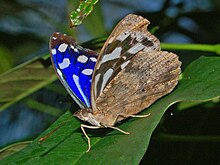
Archaeoprepona demophon, the one-spotted prepona, banded king shoemaker, or demophon shoemaker is a butterfly belonging to the family Nymphalidae.

Eumorpha vitis, known as the vine sphinx, is a moth of the family Sphingidae.

Morpho deidamia, the Deidamia morpho, is a Neotropical butterfly. It is found in Panama, Nicaragua, Costa Rica, Suriname, Bolivia, Venezuela, Colombia, Peru, Ecuador, and Brazil. It is a species group, which may be, or may not be several species. Many subspecies have been described.

The gartered trogon, also known as the northern violaceous trogon, is a bird in the family Trogonidae, the quetzals and trogons. It is found in Mexico, all of Central America, and Colombia, Ecuador, Peru, and Venezuela.
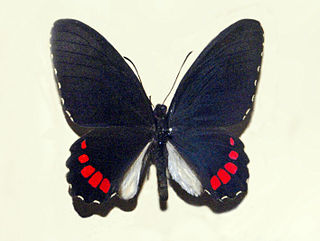
Parides erithalion, the variable cattleheart, is a North and South American butterfly in the family Papilionidae. The species was first described by Jean Baptiste Boisduval in 1836.

Papilio torquatus, the torquatus swallowtail, is a swallowtail butterfly in the subfamily Papilioninae. It is found from northern Argentina to Mexico.
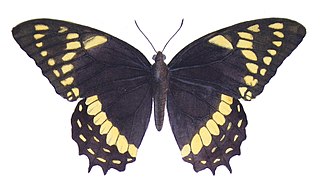
Papilio menatius is a butterfly of the family Papilionidae.

Mimoides phaon, the red-sided swallowtail or variable swallowtail, is a species of butterfly in the family Papilionidae. It is native to the Americas.
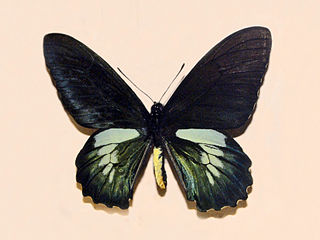
Battus laodamas, the green-patch swallowtail or yellow-spotted swallowtail, is a species of butterfly in the family Papilionidae.

Parides sesostris, the emerald-patched cattleheart or southern cattleheart, is a species of butterfly in the family Papilionidae.
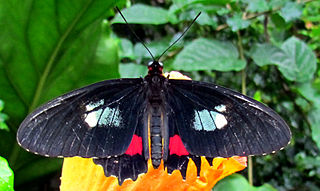
Parides iphidamas, the Iphidamas cattleheart or Transandean cattleheart, is a species of Neotropical butterfly in the family Papilionidae.

Battus ingenuus, the Dyar's swallowtail or confused swallowtail, is a species of butterfly in the family Papilionidae.
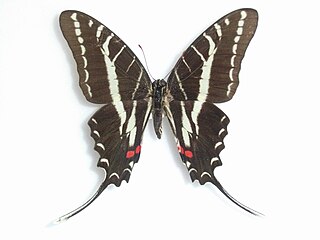
Eurytides philolaus, the dark zebra swallowtail or dark kite-swallowtail, is a butterfly of the family Papilionidae. It is found from southern Texas to northern South America.

Tithorea tarricina, the tarricina longwing, variable presonian, or cream-spotted tigerwing, is a species of butterfly belonging to the family Nymphalidae.

Eurytides agesilaus, the short-lined kite swallowtail, is a medium-sized species of butterfly in the family Papilionidae.
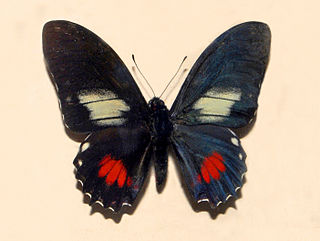
Mimoides euryleon, the false cattleheart swallowtail, is a species of butterfly in the family Papilionidae.
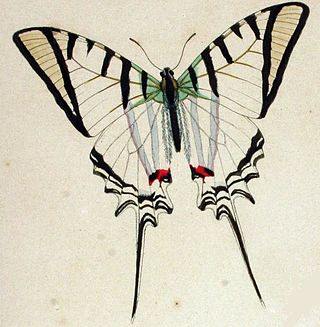
Protesilaus protesilaus is a species of butterfly of the family Papilionidae. It is found in the Neotropical realm.
Diaphania elegans is a moth in the family Crambidae. It was described by Heinrich Benno Möschler in 1890. It is found in Puerto Rico, Hispaniola, Jamaica, Cuba, Costa Rica, Panama, Guatemala, Honduras, Mexico and southern Texas. It is also found in South America, where it has been recorded from Venezuela, Trinidad, Ecuador, Peru, Brazil, Paraguay and Argentina.
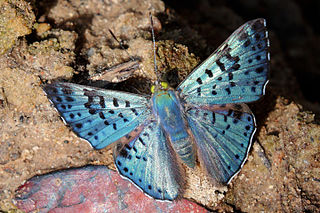
Lasaia agesilas, the glittering sapphire, black-patch bluemark or Narses metalmark is a metalmark butterfly. The species was first described by Pierre André Latreille in 1809. It is native to Central America and the north of South America. It ranges from Costa Rica, Panama, Venezuela, Trinidad, Colombia, Ecuador, Peru, Bolivia, Guyana, Argentina, to the Brazilian Amazon.

Hamadryas iphthime, the ringless blue cracker or brownish cracker, is a species of cracker butterfly in the family Nymphalidae. It was first described by Henry Walter Bates in 1864. It is found in Mexico, Central America and parts of northern South America.

